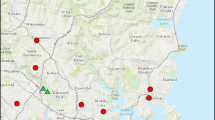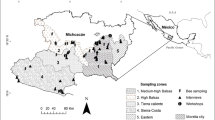Abstract
Little is known about bee communities and pollination services conservation strategies in sub-Sahara Africa. A study was conducted at 26 different sites with varying local landscape characteristics in farmlands of central Uganda in 2006. Bees were sampled using coloured pantraps, handnet and line transect counts. Overall 80,883 bee individuals from 6 families and 652 species were encountered. The bee fauna was characterized by a lower diversity of Melittidae and Andrenidae and a high diversity of Apidae, Megachilidae and Halictidae. Megachile and Lasioglossum were the two most species-rich genera. The most abundant species was Apis mellifera adansonii Linnaeus (23 % of total individuals) followed by Hypotrigona gribodoi Magretti (19 %), Meliponula ferruginea Lepeletier (13 %), Lasioglossum ugandicum Cockerell (7 %), Apis mellifera scutellata Latreille (6 %), Allodapula acutigera Cockerell (6 %), Ceratina rufigastra Cockerell (5 %), Ceratina tanganyicensis Strand (5 %), Braunsapis angolensis Cockerell (5 %), Megachile rufipes Fabricius (5 %), Meliponula bocandei Spinola (5 %) and Seladonia jucundus Smith (5 %). The mean number of species recorded per study site per day ranged between 14 and 49, whereas the abundance ranged between 188 and 1,859 individuals. Study sites in areas with intense land-use had species-poor bee communities compared to sites with medium to low land-use intensities. Study sites with riparian forest fragments and wetlands, or with forest fallows in their vicinity had significantly (P < 0.05) higher species richness and diversity than sites dominated by small-scale monoculture/polyculture fields or sites dominated by either simple or complex traditional agroforestry systems. An ordination analysis also revealed that bee communities were significantly (P < 0.01) influenced by the presence of semi-natural habitats (woodlands, fallows) and forest fragments in the surrounding of fields. Thus, natural and semi-natural habitats are of great value for afrotropical farmland bee communities. There is a need to put in place strategies and policies for semi-natural and forest fragments preservation for spatio-temporal stability of pollination services in rural landscapes. Farmers are recommended to increase on-farm trees cover to safeguard and enhance pollination function and services in fields. Mimicking natural vegetation through promoting establishment of forest plantations and village community forestry in rural landscapes is also critical for conserving pollination services.





Similar content being viewed by others
References
Ascher J, Eardley C, Griswold T, Melo G, Polaszek A, Ruggiero M, Williams P, Walker K, Warrit N (2008) World Bee Checklist Project—update 2008–09, manuscript (version 10/09/2008), [online] Integrated Taxonomic Information System. http://www.itis.gov/beechecklist.html. Accessed on: 29 Aug 2009
Banaszak J, Manole T (1987) Diversity and density of pollinating insects (Apoidea) in the agricultural landscape of Romania. Polskie Pismo Entomologiczne 57:747–766
Bolwig S, Pomeroy D, Tushabe H, Mushabe D (2006) Crops, trees, and birds: biodiversity change under agricultural intensification in Uganda’s farmed landscapes. Dan J Geogr 106(2):115–130
Brosi BJ, Armsworth PR, Daily GC (2008) Optimal design of agricultural landscapes for pollination services. Conserv Lett 1:27–36
Buschini MLT, Woiski TD (2008) Alpha–beta diversity in trap-nesting wasps (Hymenoptera: Aculeata) in Southern Brazil. Acta Zoologica 89(4):351–358
Byarugaba D (2004) Stingless bees (Hymenoptera: Apidae) of Bwindi impenetrable forest, Uganda and Abayanda indigenous knowledge. Int J Trop Insect Sci 24(1):117–121
Cane JH, Minckley RL, Kervin L (2000) Sampling bees (Hymenoptera: Apiformes) for pollinator community studies: pitfalls of pan-trapping. J Kans Entomol Soc 73:225–231
Cane JH, Minckley RL, Kervin LJ, Roulston T, Williams NM (2006) Complex responses within a desert bee guild (Hymenoptera: Apiformes) to urban habitat fragmentation. Ecol Appl 16(2):632–644
Chaplin-Kramer R, Tuxen-Bettman K, Kremen C (2011) Value of wildland habitat for supplying pollination services to Californian agriculture. Rangelands 33(3):33–41
Droege S, Tepedino VJ, Lebuhn G, Link W, Minckley RL, Chen Q, Conrad C (2010) Spatial patterns of bee captures in North American bowl trapping surveys. Insect Conserv Divers 3:15–23
Eardley CD, Gikungu M, Schwarz MP (2009) Bee conservation in Sub-Saharan Africa and Madagascar: diversity, status and threats. Apidologie 40:355–366
Gallai N, Salles J-M, Settele J, Vaissière BE (2009) Economic valuation of the vulnerability of world agriculture confronted with pollinator decline. Ecol Econ 68:810–821
Gikungu MW (2006) Bee diversity and some aspects of their ecological interactions with plants in a successional tropical community. PhD Dissertation, University of Bonn, p 201
Gordon JR, Balkwill K, Gemmill B (2004) African pollination studies: where are the gaps? In J Trop Insect Sci 24(1):5–28
Greenleaf SS, Kremen C (2006) Wild bee species increase tomato production and respond differently to surrounding land use in Northern California. Biol Conserv 133:81–87
Hoehn P, Steffan-Dewenter I, Tscharntke T (2010) Relative contribution of agroforestry, rainforest and open land to local and regional bee diversity. Biodiv Conserv 19:2189–2200
Jha S, Vandermeer JH (2010) Impacts of coffee agroforestry management on tropical bee communities. Biol Conserv 143:1423–1431
Kajobe R (2008) Foraging behaviour of equatorial Afro-tropical stingless bees: habitat selection and competition for resources. PhD thesis, University of Utrecht, Netherlands, p 128
Klein A-M, Vaissiere BE, Cane JH, Steffan-Dewenter I, Cunningham SA, Kremen C, Tscharntke T (2007) Importance of pollinators in changing landscapes for world crops. Proc R Soc Lond B 274:303–313
Kremen C, Williams NM, Aizen MA, Gemmill-Herren B, LeBuhn G, Minckley R, Packer L, Potts SG, Roulston T, Steffan-Dewenter I, Vazquez P, Winfree R, Adams L, Crone EE, Greenleaf SS, Keitt TH, Klein A-M, Regetz J, Ricketts TH (2007) Pollination and other ecosystem services produced by mobile organisms: a conceptual framework for effects of land-use change. Ecol Lett 10:299–314
Liow LH, Sodhi NS, Elmqvist T (2001) Bee diversity along a disturbance gradient in tropical lowland forests of south-east Asia. J Appl Ecol 38:180–192
Loyola RD, Martins RP (2008) Habitat structure components are effective predictors of trap-nesting Hymenoptera diversity. Basic Appl Ecol 9:735–742
Lynam T, Cunliffe R, Mapaure I, Bwerinofa I (2003) Assessment of the value of wood landscape functions to local communities in Gorongosa and Muanza Distrctis, Sofala province, Mozambique. CIFOR publication, Jakarta, p 11
Magurran AE (2004) Measuring biology diversity. Blackwell Publishing Ltd, Oxford 256 pp.
Martins DJ (2004) Foraging patterns of managed honeybees and wild bee species in an arid African environment: ecology, biodiversity and competition. Int J Trop Insect Sci 24(1):105–115
Meléndez-Ramirez V, Magaña-Rueda S, Parra-Tabla V, Ayala R, Navarro J (2002) Diversity of native bee visitors of cucurbit crops (Cucurbitaceae) in Yucatán, México. J Insect Conserv 6:135–147
Michener CD (2007) The bees of the world. The John Hopkins University Press, Baltimore, p 913
Morandin LA, Winston ML (2006) Pollinators provide economic incentive to preserve natural land in agro ecosystems. Agric Ecos Environ 116:289–292
Munyuli, TMB (2010) Pollinator biodiversity and economic value of pollination services in Uganda. PhD Dissertation, Makerere University, Kampala, Uganda, p 431
Munyuli TMB (2011a) Factors governing flower-visitation patterns and quality of pollination services delivered by social and solitary bee species to coffee in central Uganda. Afr J Ecol 49:501–509
Munyuli TMB (2011b) Farmers’ perceptions of pollinators’ importance in coffee production in Uganda. Agric Sci 2(3):318–333
Munyuli TMB (2011c) Pollinator biodiversity in Uganda and in Sub-Sahara Africa: landscape and habitat management strategies for its conservation. Int J Biodiv Conserv 3(11):551–609
Munyuli TMB (2011d) Assessment of indicator species of butterfly assemblages in coffee–banana farming system in central Uganda. Afr J Ecol 50:77–89
Munyuli TMB (2012a) Diversity of life-history traits, functional groups and indicator species of bee communities from farmlands of central Uganda. Jordan J Biol Sci 5(1):1–14
Munyuli TMB (2012b) Micro, local, landscape and regional drivers of bee biodiversity and pollination services delivery to coffee (Coffea canephora) in Uganda. Int J Biodivers, Ecosyst Serv Manag (in press)
Munyuli TMB, Kasina M, Lossini J, Mauremootoo JR, Eardley C (2011) Bee genera of East Africa (Kenya, Uganda and Tanzania), Lucid v. 3.5 key and fact sheets. KARI, TPRI, PPRI, Busitema University, BioNET-EAFRINET, CABI & University of Queensland. http://keys.lucidcentral.org/keys/v3/EAFRINET
Nemésio A, Silveira FA (2007) Diversity and distribution of orchid bees (Hymenoptera: Apidae) with a revised checklist of species. Neotropic Entomol 36(6):874–888
Potts SG, Kevan PG, Boone JW (2005) Conservation in pollination: collecting, surveying and monitoring. In: Dafni A, Kevan P (eds) Pollination ecology: a practical approach. Enviroquest, Cambridge
Roubik DW (1995) Pollination of cultivated plants in the tropics. FAO, Rome
Roulston TH, Smith SA, Brewster AL (2007) A comparison of pan trap and intensive net sampling techniques for documenting a bee (Hymenoptera: Apiformes) fauna. J Kans Entomol Soc 80:179–181
Steffan-Dewenter I, Westphal C (2008) The interplay of pollinator diversity, pollination services and landscape change. J Appl Ecol 45:737–741
Timmermann K, Kuhlmann M (2008) Redefinition of the Southern African Bee Subgenera Patellapis (s. str.), P. (Chaetalictus), P. (Lomatalictus) (Hymenoptera: Halictidae, Genus Patellapis Friese, 1909. J Kans Entomol Soc 81(4):355–367
Tuell JK, Fiedler AK, Landis D, Isaacs R (2008) Visitation by wild and managed bees (Hymenoptera: Apoidea) to Eastern U.S. Native plants for use in conservation programs. Environ Entomol 37(3):707–718
Watson JC, Wolf A, Ascher JS (2011) Forested landscapes promote richness and abundance of native bees (Hymenoptera: Apoidea: Anthophila) in Wisconsin apple orchards. Environ Entomol 40(3):621–632
Westphal C, Bommarco R, Carré G, Lamborn E, Morison N, Petanidou T, Potts SG, Roberts SPM, Szentgyörgyi H, Tscheulin T, Vaissière BE, Woyciechowski M, Biesmeijer JC, Kunin WE, Settele J, Steffan-Dewenter I (2008) Measuring bee biodiversity in different habitats and biographic regions. Ecol Monogr 78(4):653–671
Wilson JS, Messinger OJ, Griswold T (2009) Variation between bee communities on a sand dune complex in the Great Basin Desert, North America: implications for sand dune conservation. J Arid Environ 73:666–671
Winfree R (2010) The conservation and restoration of wild bees. Ann N Y Acad Sci 1195:169–197
Acknowledgments
We are very grateful to Darwin Initiative (Defra, UK; project reference: 14-032; project title: Conserving biodiversity in modernized farm landscapes in Uganda) for funding this study. We are also very grateful to bee taxonomists: Dr. Connal Eardley (RSA), Dr. David Roubik (Smithsonian Tropical Institute Panama), Dr. David Notton (London Museum of Natural Historiy UK) and to Mr.Roberts Stuart (University of Reading, UK). Mr. Maurice Mutabazi (research assistant) is thanked for his assistance in the field. Early comments from anonymous reviewers of this journal are acknowledged.
Author information
Authors and Affiliations
Corresponding author
Additional information
This paper has been retracted. The decision is made jointly by the editor and Springer after an investigation following the comments of the named authors. The retraction is on the basis that some of the co-authors did not agree to the submission of the manuscript and were unaware that it had been submitted. It is the policy of the journal that all authors must agree to the submission of a manuscript in which they are named as an author.
An erratum to this article is available at http://dx.doi.org/10.1007/s10841-014-9622-z.
Appendix
Appendix
See Fig. 6.
About this article
Cite this article
Munyuli, M.B.T., Nyeko, P., Potts, S. et al. RETRACTED ARTICLE: Patterns of bee diversity in mosaic agricultural landscapes of central Uganda: implication of pollination services conservation for food security. J Insect Conserv 17, 79–93 (2013). https://doi.org/10.1007/s10841-012-9488-x
Received:
Accepted:
Published:
Issue Date:
DOI: https://doi.org/10.1007/s10841-012-9488-x





